

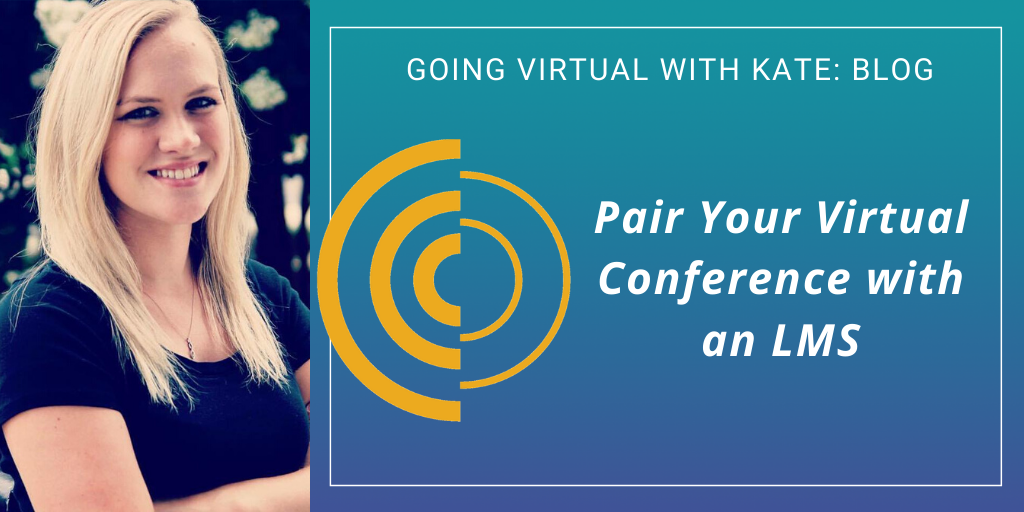
Pair Your Virtual Conference with an LMS
The reality of transitioning to a Virtual Conference can be as simple or complex as planning a traditional on-site event, depending on the needs of your organization. As CommPartners sees inquiries come in for Virtual Conferences, one question we hear often is, “is an LMS platform really necessary?”
In short, we believe, yes! An LMS or Learning Management System, like CommPartners’ Elevate, allows you to house all your conference resources in one place and creates a space for attendee engagement. Your LMS will be an enduring knowledge presence that makes your learners want to come back to your site for content and information repeatedly. An LMS also opens doors for new ways to monetize online learning as a fresh, constant source of content for your clients and members!
A Home Full of Resources
An LMS platform provides a place for your attendees to return throughout your Virtual Conference. They can reference things like the agenda, speaker bios, virtual tradeshow booths, uploaded resources, and more! Just like an in-person conference or exhibit hall, your attendees will be able to explore your LMS platform to find new and interesting information. An LMS will house a full catalog of resources for attendees, simplifying their experience by eliminating the need for multiple platforms.
Community, Online
One of the biggest concerns when moving from an on-site conference to a Virtual Conference is the elimination of human interaction. Learners attend these events to network and connect with people, and online that doesn’t seem possible. An LMS like Elevate can provide you with many options to bridge the gap between attendees, including discussion boards on the conference site or a specific session, live chat, and Q&A with the presenters during a live broadcast and one-to-one chat messaging! Peer-to-peer conversations, discussions with presenters, and live reactions will create a sense of human interaction in a virtual space.
A Stream of Content
By building an LMS platform now, you can secure a solid foundation for future online events and even create a new, constant source of information for clients and members. Plus, if your organization would want to produce another event, you would already have the tools, site, and team in place to implement. Not to mention, your attendees would have continued access to resources provided by you. With an established LMS, you have the option to add virtual components to any future on-site events. Attendees would also have the ability to refer back to the recordings of your conference to refresh themselves on what they had previously learned. By building an LMS into your crisis solution now, you are securing your organization for a sustainable future.
Make Money While Solving a Problem
The current need is for a virtual solution. Just because you are strategizing how to move forward in difficult times, doesn’t mean it should be at a loss! There are many options within an LMS to monetize your online offerings outside of registration fees. An LMS offers a constant source of resources, like creating subscription plans for your learners to access resources. You can brand pages with sponsors, play sponsor commercials in breaks, and feature ads in various areas of the platform. You can charge for virtual booth space in addition to the on-site booth, should you move forward with an on-site program. Monetizing Your Virtual Conference may mean a new way of creative thinking, but it is entirely possible to do!
While creating your virtual solution for this new challenge, it is wise to slow down, even for a brief moment, and analyze the long term return on investment. With so many uncertainties lingering, creating an LMS will enable you to maximize your remote presence.
Learn More
Watch all the On-Demand Facebook Live Episodes Here!
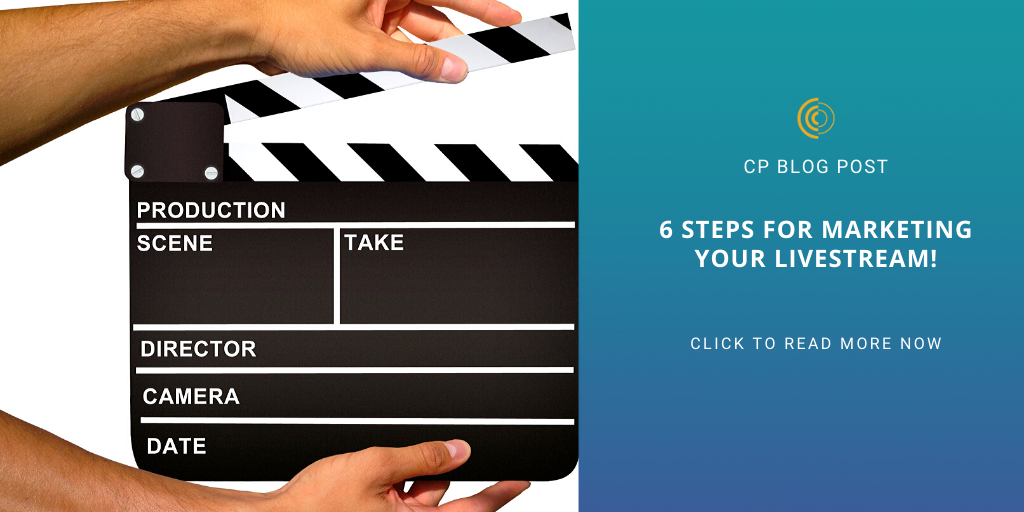
6 steps for marketing your livestream!
Livestreaming is an exciting move for your organization and an opportunity to reach even more people. While you may feel energized about this change, your attendees may be cautious and apprehensive.
Follow these 6 steps to market your new jump into the technological age!
1. Define your offerings and goals
Before you begin your marketing efforts, you must know what you are selling. This should always be the first step of a marketing team, asking the questions. Below you will find a few examples of things to consider, be sure you are exploring your offerings from a micro and macro level!
- Are you offering on-site and virtual attendance options or, is this a strictly virtual event?
- When the attendee registers for the livestream, what do they receive? Is it access to (1) individual session, or will they receive the whole conference?
- Will there be access to slide decks or other resources for all attendees?
- Will attendees have the opportunity to receive credit or certifications?
- Would you personally register for this conference? Do the pricing and offerings match?
After you have defined all of the offerings, you can now begin identifying goals. Your goals can be as simple as a registration or monetary goal, or as complex and long-term as return registrations or ongoing community discussions. Your goals should follow the SMART guidelines. They need to be Specific, Measurable, Attainable, Relevant, and Time-bound. The goals you set should also be organization specific. For example, your organization may need to make a profit off this livestream or it may need to build membership. Your goals will be used to measure success. Remember – success is not a one size fits all model; it is fluid and ever-changing!
2. Create a Plan
Now you know what you are offering and how you define success, next you need to create your plan! When developing your marketing plan, it is important to consider, once again, macro and micro perspectives. Start by looking at the “bigger picture,” i.e., how much time do you have, what marketing platforms and methods are you planning to use, what resources do you already have, etc.?
It can help to create a timeline from now ending with your livestream event. Set benchmarks that will que you to check on your progress. You should ask yourself, “am I on target for my goals” regularly and then use you marketing plan to either maintain your current efforts or tweak aspects of the plan that are not working to successfully reach your benchmarks.
3. Know your audience and their preferred communications
Have you ever tried to have a conversation with someone who doesn’t speak your language and you don’t speak theirs? No matter what you are trying to communicate, the other person does not know the details, but rather only what they can surmise from watching your non-verbal communications.
The same idea is applied to marketing. If you are getting your promotions out on Facebook, but your intended audience primarily uses LinkedIn, you will find your audience may only be picking up portions of your message, and not benefiting from all the right information!
You also may want to take a look at your method of communication based on certain subgroups. For example, you may be trying to market to a specific organization that practices law in the United States, but that group has very specific sub-sets within itself. Younger age groups may get their information from Instagram, while an older age group may prefer email. Segmenting your marketing efforts and tailoring the messages to those sub groups will ensure that the right information is getting to the right people.
4. Recognize what makes a livestream different
Livestreams offer a cost-effective and time-efficient way for attendees to obtain the same information without the hassle of travel and taking time off to be on-site. Many busy professionals prefer to multi-task during their day, and livestreaming your conference ensure they get the right content without turning they daily routine upside down.
Event recordings are a great way for registrants to re-watch the presentations later for a refresher, or they can visit the recording at a more convenient time.
Identifying your livestreams unique characteristics will help you market to attendees. Why is it important for attendees to register for your livestream? Is there credit associated for the presentations? Do they have to watch it live or can they still obtain credit watching the recording? Ask yourself, “why did we decide to livestream in the first place?”. Chances are you will find the reasons why your audience should register.
Once you have identified what makes a livestream different, market as you would for anything else, highlighting the products unique characteristics.
5. Make it personal
While a lot of your marketing efforts can be automated, that will make the messaging less personal and easier to delete or ignore. When marketing your livestream, it is important to make sure that you are offering a personal experience, because that is one thing potentially lost when an audience member is virtual.
When you are in-person at a conference, the whole experience is more personal because you are experiencing it with all your senses. A livestream takes away a certain personalization, and it is our job to compensate with catering marketing and course offerings to them.
A few ideas to make the experience more personal:
- Ask for input: What does your target audience want to see, hear and/or learn? People love to know that their voice matters! How awesome is it if you ask to hear about a particular topic, and then it actually is presented on!
- Ask for feedback: Again, people want to be heard! If this isn’t your first event, ask the past attendees for their feedback, and entice them to come see their suggestions in action! The main difference here is that you are receiving reviews based off what you’ve already done!
- Create a Community: Learning online creates its own challenges, but luckily, technology can help. Allow your virtual audience to communicate with each other and their instructors through chat features in the course and discussion boards!
- Create a personal email/phone marketing campaign: Provide your team with an email or script that has a few customization options. Those customization options could be a variety of reasons to attend or the session content/titles. When your team reaches out to attendees, they can pick from the provided options to personalize the message and make attendance more enticing.
Back to Top of Post
6. Get creative
Don’t be afraid to try new things! With the advances in technology, you can leverage so many more tools to make your event an exciting one to register for! Here are a few ideas
- Contests with prizes: Using a variety of technologies and platforms, you can make a game or raffle contest online!
- Harness the power of video: People love to see and feel excitement for the event; it makes them feel like they are part of it. Live broadcast on social media with your presenters, sharing excitement, or sneak peeks!
- Use the voice of your partners: Create a human connection by using quotes from past attendees, speakers, and team members in your various marketing efforts.
Any marketing campaign takes time and resources to complete successfully, but using these 6 steps will help you better organize your efforts!
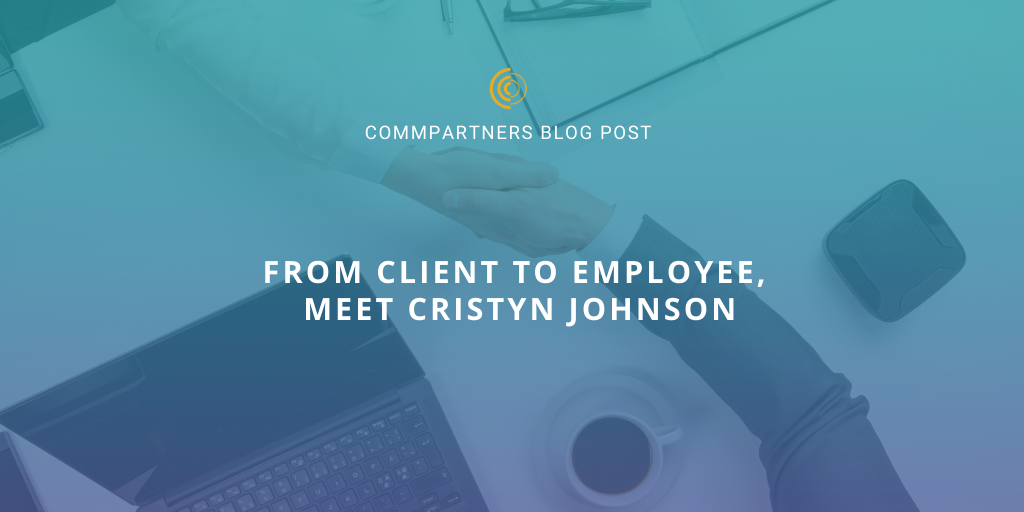
From Client to Employee, Meet Cristyn Johnson

Cristyn Johnson is the newest addition to the CommPartners team. She may be a new name to some clients, but she no stranger to Elevate or CommPartners. Cristyn is a former client who has joined us as a Client Development Manager. She told me a little bit about her position, what it was like to transition from client to team member, and what unique perspectives she brings to the table.
JR: What is your job title, and what will you be doing for CommPartners?
CJ: I am a Client Development Manager. I will be working with all existing clients – that includes Elevate, content capture, live-stream clients – helping them optimize their systems, brainstorming new ideas and initiatives they might be excited to embark on, and making sure they get the most out of our services.
JR: Exciting! What aspects of your new position are you looking forward to the most?
CJ: I am a huge professional development and learning nerd, so I am really looking forward to learning about all of the really cool projects and initiatives our clients are doing or could be doing with CommPartners.
JR: How about association education? What makes you excited working in this space?
CJ: I get really excited when other people get really excited about learning.
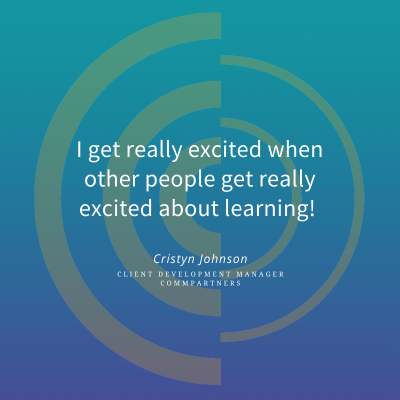
JR: Sounds like you’re in the right industry! So, you have the unique experience of coming to CommPartners as a former client, can you speak to what that transition was like?
CJ: In my previous position, I was managing our Elevate platform. As the position grew, I found myself drawn to helping others use the platform more effectively, think critically about how they use the platform, and how the end-users use the platform. So, it seemed serendipitous when this position at CommPartners became available where I could similarly help other Elevate administrators across the platform.
JR: Do you think that experience has given you a unique perspective you can use in your new position?
CJ: Absolutely! I think the association world is very unique with so many dynamics and strategies and ideas, and having that deeper knowledge is going to help me make more informed recommendations to clients. It also means, we can have a certain level of insight that we didn’t necessarily have before, new initiatives or new products can have an added association perspective built into the way they are created.
JR: Now that you’re working for CommPartners, what makes us unique compared to other online education companies you have worked with/have experience with?
CJ: CommPartners takes the time to listen and get to know all of our clients, and I felt that interaction when I was on the other side as a client too. That goes a long way in the association world because a lot of them are not-for-profit entities, other companies can write them off as a faceless name in a crowd – you don’t feel that with CommPartners.
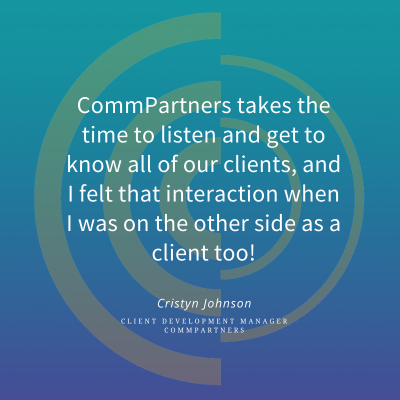
JR: What’s a unique element of Elevate that really excites you?
CJ: Elevate has a module called Connect. It is a great way to connect all your users within your LMS. Where on a discussion board the conversation just kind of ends, the Connect Module allows you to create an interactive community with all of your Elevate users. Users can talk and share resources beyond single product interaction.
JR: Bonus question round! What is one movie you can watch over and over and over?
CJ: Slums of Beverly Hills!
Cristyn is looking forward to working with our clients to make sure they are getting the most out CommPartners’ products and services. If you have an idea you’d like to try out within your education services or feel like your education toolbox could use a refresh, contact Cristyn.
She is ready to find a new way to engage your learners or maybe better leverage what you already have.
Cristyn can be reached by email cjohnson@commpartners.com or phone (443) 539-4858.
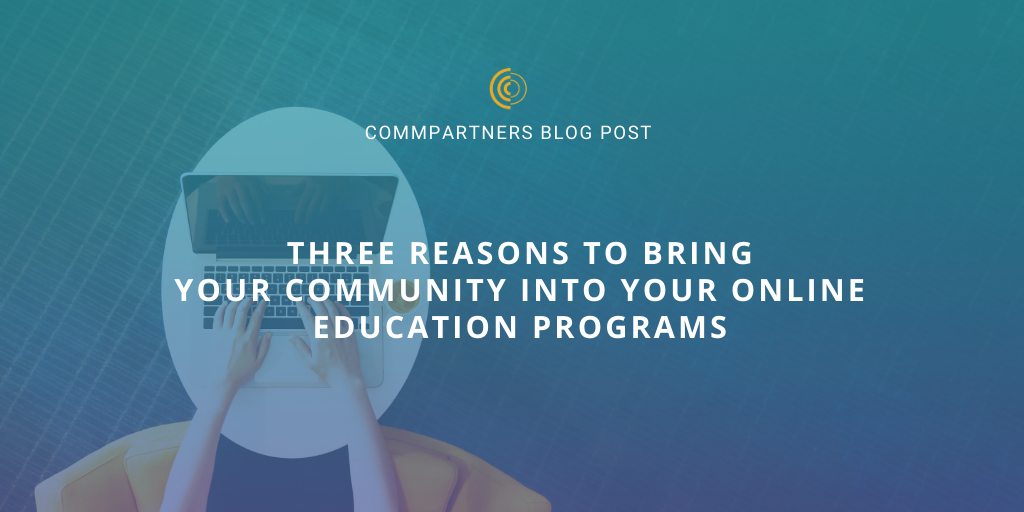
Three Reasons to bring your Community into your Online Education Programs
Yesterday, I had the opportunity to present at the 2019 Higher Logic Super Forum, on the topic of community-based learning. At the start of the session, I discussed the difference between training and learning. I suggested that training tends to be one dimensional or instructional, in support of a specific process or job with a singular path towards the end goal. Learning can be described as a multi-dimensional approach, that links educational experience and work performance. It focuses on personal qualities and situational decision making. Too often online education programs that fit well into the learning space are structured as training. The problem is, there is little space created for engagement, conversation and sharing of ideas and this leads to minimal learner to learner or learner to instructor engagement.
A way to address this situation is to create space for sharing of ideas, reflection and connection among participants. This was one of the initial goals when we formed a close partnership with Higher Logic to bring learning and community together as a single offering. While we have had some success achieving this on a macro level with an integrated user experience (UX), a single menu structure and seamless integration, we have not had great progress on a content level.
In my talk yesterday, I made the case that if you are offering online learning that is enhanced from a collaboration among participants, an integration of your community and LMS on a program level makes a lot of sense. Here are three benefits of integrating discussions within your online course, virtual conference or webinar offerings:
- Your community members have already taken time to set up their profile and participate in the community. They can now leverage that presence to engage fellow learners in a more focused way. Adding online education to their participation makes them more active and creates synergy between the two platforms, therefore increasing participation.
- Satisfaction with a course will be enhanced when there is the opportunity to share ones ideas or thoughts with other learners.
- Adding discussions provides a continuum of what is learned. It provides participants the opportunity to continue with the topic once the course is completed.
Recently, CommPartners enhanced its integration between Higher Logic’s Community and CommPartners’ Elevate LMS. Is it time for you to make this a priority in 2020?
If you have questions on how to move forward with community based learning, contact Meghan Gowen, VP of Client Development at mgowen@commpartners.com

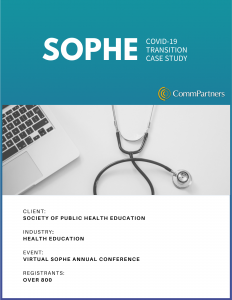 The COVID-19 pandemic caused the event industry to go into a tail-spin. Organizations all over the world were forced to cancel and postpone their events. The Society of Public Health Education, SOPHE, did not want to miss out on the many positive opportunities a conference can bring to an association and decided to take advantage of the Virtual Conference option.
The COVID-19 pandemic caused the event industry to go into a tail-spin. Organizations all over the world were forced to cancel and postpone their events. The Society of Public Health Education, SOPHE, did not want to miss out on the many positive opportunities a conference can bring to an association and decided to take advantage of the Virtual Conference option.